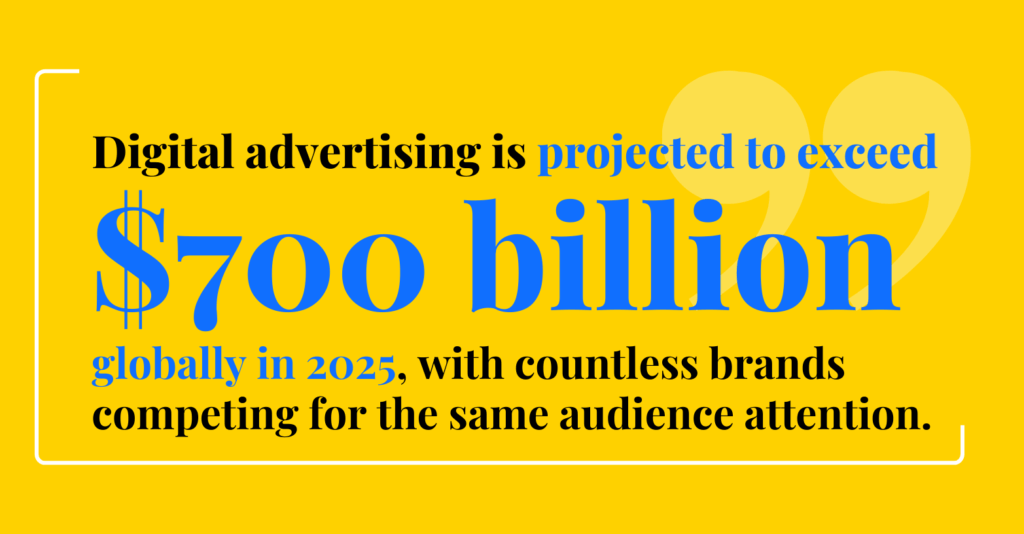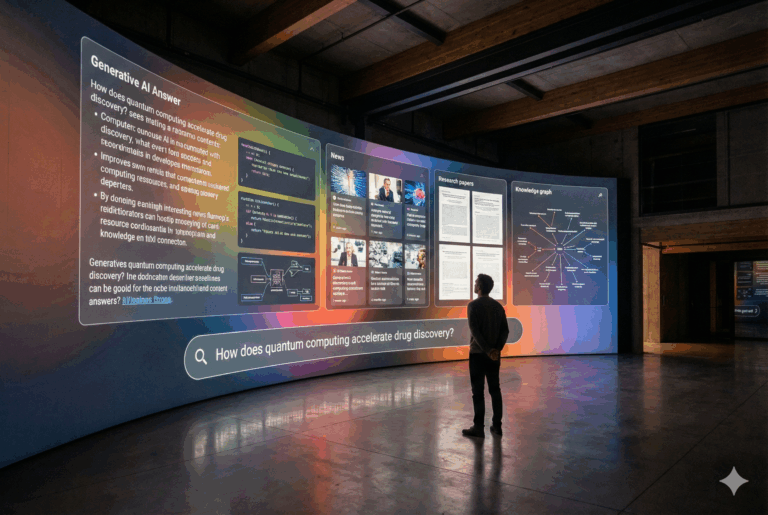With the rise of AI and automation, eCommerce advertising is more efficient than ever. If your site is underperforming, it’s time to get in the game.
Digital advertising is projected to exceed $700 billion globally in 2025, with countless brands competing for the same audience attention.

The game is changing quickly. While AI automation is handling bid management in increasingly sophisticated ways, privacy regulations are forcing everyone to get smarter about first-party data. Meanwhile the platforms themselves are consolidating the market, with three major players—Google, Meta, and Amazon—now controlling most of your advertising space online.
The advertisers winning in this environment aren’t spending more, they’re spending smarter.
Are you ready to outsmart the competition with digital ads that convert?
In this guide:
- Building an Effective eCommerce Advertising Strategy
- Defining Your eCommerce Advertising Goals
- Platform-Specific eCommerce Advertising Channels
- Omnichannel Coordination and Budget Allocation
- Scaling and Optimizing Your Advertising Program
- Advanced eCommerce Advertising Tactics
- Common Pitfalls and How to Avoid Them
- Future Trends and Emerging Technologies
- Winning the Next Era of eCommerce Advertising
At Session Interactive, we help brands navigate the ever-changing landscape of search marketing. By analyzing performance trends and uncovering hidden gaps and opportunities, we develop tailored paid search solutions that drive audience engagement and revenue.
Our team combines years of platform expertise with data-driven insights to refine targeting, adjust bids, and optimize creatives. We turn paid media into a predictable driver of revenue.
Building an Effective eCommerce Advertising Strategy
Let’s start by breaking down how to develop a winning eCommerce advertising strategy.
Understanding Your Market
Before you spend a dollar on ads, you need to understand what you’re walking into.
Start with competitive intelligence. Use tools like SEMrush or Ahrefs to see where your competitors are spending money. Look at their ad copy, landing pages, and seasonal patterns. You’re not copying them; you’re understanding the playing field.
Next, map out demand dynamics in your category. Are you in a seasonal business where Q4 drives 40% of revenue? Is your market growing or contracting? Understanding these patterns helps you allocate budget intelligently instead of spreading yourself too thin across twelve months.
Pay attention to pricing pressures and consumer behavior shifts. If your customers are increasingly price-sensitive, that changes everything about your ad strategy. If they’re shopping on mobile but buying on desktop, that changes how you structure campaigns.
Identifying and Segmenting Your Target Audience
Customer segmentation in 2025 goes way beyond demographics. Age and gender don’t tell you much about purchase intent.
Use behavioral data to create segments that matter for your site. High-value customers who buy multiple times per year need different messaging than one-time holiday shoppers, and customers who browse for weeks before buying need different touchpoints than impulse purchasers.
First-party data is gold here. Customer purchase history, email engagement, and website behavior tell you more than any third-party audience ever will. With iOS privacy changes affecting 95% of users, your own data is often the only reliable targeting option.
Build lookalike audiences based on your best customers, not your biggest audiences. A lookalike of customers with high lifetime value will outperform a lookalike of email subscribers every time.
Mapping Your Customer Journey
Most customer journeys in eCommerce involve 5-7 touchpoints before purchase. Pretending people see one ad and buy immediately is expensive wishful thinking.
Start by mapping awareness stage touchpoints. This is where video content, social media, and display advertising introduce your brand. You’re not looking for immediate conversions here—you’re building audience pools for later retargeting.
The consideration stage is where search advertising and retargeting shine. People are actively looking for solutions and comparing options. Your job is showing up when they’re ready to engage.
The decision stage requires social proof, reviews, and clear value propositions. This is where cart abandonment campaigns, customer testimonials, and limited-time offers make the difference.
Don’t forget post-purchase. Customer lifetime value depends on what happens after the first sale. Email campaigns, loyalty programs, and cross-sell advertising can double the value of each customer acquisition.
Defining Your eCommerce Advertising Goals
Wish as we might, impressions just don’t pay the bills.
Focus on metrics that tie directly to business outcomes. Customer Acquisition Cost (CAC) should vary by channel, from $21 for arts and entertainment up to $377 for electronics. Your target depends on customer lifetime value, not what competitors are doing.
Return on Ad Spend (ROAS) varies dramatically by platform and industry. Google Search can deliver 18:1 ROAS in apparel, while Facebook typically ranges from 2.7-3. Set realistic targets based on your industry benchmarks, not wishful thinking.
Lifetime Value (LTV) to CAC ratio should hit at least 3:1. Anything below that and you’re buying customers at unsustainable prices. The best performers achieve 5:1 or higher by focusing on retention and cross-selling.
Establishing Metric Tracking and Attribution Models
Building comprehensive tracking starts with proper Google Analytics 4 ecommerce configuration. Enable Enhanced Ecommerce events (purchase, add_to_cart, begin_checkout) and set up audiences based on purchase behavior. These are your highest-value retargeting lists. Connect GA4 to Google Ads for automated bidding optimization, but understand that client-side tracking now faces serious limitations. Ad blockers, browser restrictions, and iOS 14.5+ updates mean traditional client-side methods capture incomplete data, creating gaps in your attribution models.
That’s why we advocate server-side tracking for most clients focused on marketing attribution. While client-side tracking is easier to implement, server-side tracking delivers superior data accuracy by processing information directly on the server, bypassing browser limitations entirely. We’ve seen companies capture around 25% more sessions and sales when they implement server-side tracking, which leads to improved ROI on ad campaigns since session and conversion data isn’t lost to ad blockers or privacy settings.
For CRM integration, connect customer data platforms to advertising platforms using first-party data matching—this creates unified customer profiles that improve targeting accuracy across the entire customer lifecycle.
The technical complexity requires upfront investment, but the long-term benefits of improved data quality, enhanced privacy compliance, and robust attribution make it essential for serious eCommerce operations.
Platform-Specific eCommerce Advertising Channels
Platform share remains dominated by Google, Meta, and Amazon. Here’s what we’ve learned about each of these advertising spaces.
Google Advertising
Google remains the heavyweight with projected revenues exceeding $200 billion in 2025. The platform controls intent-driven traffic better than anyone else.
Performance Max campaigns are delivering 9%+ conversion increases when properly optimized. But they require at least 30 conversions per month to function effectively. Start with Search campaigns to build conversion volume, then expand to Performance Max.
Smart Bidding strategies are now mandatory; Enhanced CPC was deprecated in March 2025. Target ROAS bidding works best when you have clear profit margins and sufficient conversion data. Target CPA works when you know exactly what you can afford to pay for customers.
Google Shopping commands 65% of Google Ads clicks. Product feed optimization isn’t optional—poor feed quality kills campaign performance. Use GTINs when available (they improve clicks by 20%), write descriptive titles under 150 characters, and maintain accurate inventory levels.
YouTube advertising reaches 2 billion logged-in users monthly. Video ads under 30 seconds with fast-paced editing see view rates of 5-15% and conversion rates of 2-5% for eCommerce campaigns. Focus on mobile-first creative since 70% of YouTube watch time happens on mobile.
Meta: Facebook and Instagram Ads
Meta’s advertising platform serves 3 billion users across Facebook and Instagram. The iOS 14.5 changes hit hard, but the platform has adapted with improved AI and broad targeting strategies.
Advantage+ Shopping Campaigns deliver 17% lower cost per action compared to traditional campaigns (Social Media Examiner). The AI works better with broader audiences—narrow targeting often underperforms now that detailed targeting options are limited.
Creative quality matters more than ever. The platform prioritizes original content over recycled assets. Short-form video content (reels) gets preferential organic reach, which amplifies paid promotion effectiveness.
Upload comprehensive customer lists for Custom Audiences: they’re more reliable than interest-based targeting. Lookalike audiences based on high-value customers outperform demographic targeting by significant margins.
Instagram drives 29% of users to make purchases directly on the platform. Instagram Shopping ads with product tags see higher engagement than standard feed ads. Use square (1:1) or vertical (4:5) aspect ratios for feed placement optimization.
Amazon Advertising
Amazon controls 77% of US retail media spend (BCG). The platform offers unique access to high-intent shoppers with first-party purchase data that other platforms can’t match.
Sponsored Brands work best for brand awareness and driving traffic to your Store page. These campaigns require Brand Registry but can significantly improve organic ranking for targeted keywords. Use video creative when possible—it outperforms static images consistently.
Amazon DSP opens programmatic buying across Amazon properties and external sites. It requires minimum budgets around $10,000 monthly but offers sophisticated audience targeting based on Amazon’s purchase data. Most valuable for retargeting and conquesting competitor customers.
Product listing optimization directly impacts ad performance. High-quality images with lifestyle contexts increase click-through rates by 40%. Competitive pricing matters—being within 10% of the lowest price significantly improves ad effectiveness.
TikTok Ads
TikTok leads social commerce with 49.7% of users making monthly purchases through the platform. The audience skews younger, but purchasing power is real and growing.
TikTok’s algorithm favors authentic, native-feeling content. Videos between 21-34 seconds perform best, with 63% of successful ads incorporating music and 55.7% seeing improvements when using captions.
Spark Ads let you promote organic posts (your own or creators’), which often outperform traditional ads by feeling more native to the platform. Partner with micro-influencers (5K-30K followers) for cost-effective content creation and authentic promotion.
The platform’s automated bidding works well for eCommerce. Start with Lowest Cost bidding and sufficient budget to allow algorithm optimization. TikTok’s AI needs volume to perform—underfunded campaigns struggle to find optimal audiences.
Omnichannel Coordination and Budget Allocation
Successful eCommerce marketing requires orchestrating campaigns across multiple platforms with strategic budget allocation that leverages each channel’s unique strengths to maximize ROAS.
Media Mix Planning Across Platforms
Smart budget allocation starts with understanding each platform’s strength.
- Google captures bottom-funnel intent.
- Meta excels at discovery and retargeting.
- Amazon reaches high-intent shoppers.
- TikTok drives social commerce among younger demographics.
Budget allocation depends heavily on your specific business model and customer behavior. As a starting framework, many successful eCommerce companies allocate 40-50% of marketing budget to paid advertising, with Google Ads typically claiming the largest share due to search intent, followed by Meta for discovery and retargeting, Amazon for high-intent shoppers, and smaller portions for testing emerging platforms.
Seasonal planning requires front-loading Q4 budgets. For many eCommerce sites, Black Friday and Cyber Monday should get the bulk of Q4 spend, but preparation starts in August. Increase budgets 50-100% during peak seasons while maintaining daily pacing controls to avoid early budget exhaustion.
Test smaller platforms with 5-10% of budget before major commitments. Reddit Ads show 30.9% year-over-year growth with minimum daily budgets of just $5. Pinterest works well for visual categories. LinkedIn targets B2B customers effectively.
Creative Strategy and Cross-Platform Cohesion
Maintain consistent brand messaging while adapting creative to platform requirements. Instagram needs vertical video, Google Search requires compelling ad copy, and Amazon demands product-focused creative.
Develop modular creative assets that adapt across platforms. A single product photoshoot can generate static ads, video content, carousel posts, and shopping catalog images. Plan creative production with multi-platform usage in mind.
User-generated content outperforms branded content for 93% of marketers. Build systems to collect and repurpose customer photos, reviews, and videos. UGC feels authentic and performs better across all platforms.
Test creative systematically using the 3-2-2 method: 3 creative variations, 2 primary text options, 2 headline variations. This gives algorithms multiple options to optimize while keeping creative testing manageable.
Campaign Orchestration and A/B Testing
Coordinate campaign launches across platforms for maximum impact. Stagger testing to avoid interference—don’t launch major tests on multiple platforms simultaneously.
Build testing roadmaps with clear hypotheses and success metrics. You should test one variable at a time: audience, creative, or bidding strategy. Mixed tests make it impossible to understand what drove performance changes.
Use holdout groups to measure incrementality. Not all attributed conversions are incremental: some customers would have purchased anyway. Proper testing reveals the true advertising impact beyond platform attribution claims.
Document and share learnings across teams. A winning audience segment on Facebook might inform Google audience targeting. Successful ad copy themes can inspire email marketing. Break down silos to leverage insights across channels.
Scaling and Optimizing Your Advertising Program
Digital advertising allows a tremendous amount of customization of specific programs, allowing for optimization unheard of in other channels. Here are some strategies for optimizing.
Automation and AI-Driven Optimization
Embrace AI-powered bidding strategies—they consistently outperform manual management at scale. The key is providing sufficient conversion data for algorithms to optimize effectively.
Set up automated rules for budget management and performance monitoring. Increase budgets automatically when campaigns exceed target performance. Pause underperforming ad groups before they waste significant budget. Automate routine optimization tasks to focus human effort on strategy.
Use platform-native automation tools like Meta’s Advantage+ and Google’s Performance Max. These campaigns require less manual management while often delivering superior results. But monitor performance closely. Automation isn’t “set and forget.”
Test AI-powered creative tools for rapid asset generation. 80% of merchants who use Product Studio see it as an efficiency-builder. Use AI to scale creative production, not replace strategic thinking.
Audience Enrichment and First Party Data Strategy
First-party data is your competitive advantage in the privacy-first advertising landscape. Build systems to collect customer preferences, purchase history, and engagement data across all touchpoints.
Implement progressive profiling to gather customer data over time. Ask for email addresses before requiring phone numbers. Request preferences after customers make purchases. Build trust before asking for sensitive information.
Use Customer Data Platforms (CDPs) to unify data from all sources. Create unified customer profiles that inform advertising strategy across platforms. The investment pays dividends in targeting accuracy and campaign performance.
Develop zero-party data collection strategies. Surveys, quizzes, and preference centers provide valuable targeting information that customers willingly share. Use this data to create sophisticated audience segments that outperform platform-generated audiences.
Quarterly Planning and Continuous Improvement
If you don’t think there’s room for improvement, you probably just haven’t identified it yet.
Conduct quarterly business reviews focused on efficiency metrics and strategic alignment. Analyze ROAS, CAC, and LTV trends across all channels. Identify budget reallocation opportunities based on performance data.
Build testing roadmaps that align with business priorities. If you’re launching new products, plan creative and audience tests. If you’re expanding to new markets, test geographic targeting strategies. Connect testing to business outcomes.
Monitor competitive activity and market changes that impact strategy. New platform features, algorithm updates, and competitor campaigns all affect performance. Stay informed and adapt quickly to maintain competitive advantage.
Set realistic performance benchmarks based on historical data and industry standards. Gradual improvement over time beats sporadic optimization efforts. Build continuous improvement into campaign management processes.
Advanced eCommerce Advertising Tactics
Beyond basic campaign setup, sophisticated eCommerce brands deploy advanced targeting, automation, and optimization techniques that significantly outperform standard advertising approaches.
Remarketing and Retention Strategies
Cart abandonment affects 70% of all shopping carts, making recovery campaigns essential. Implement multi-channel recovery sequences combining email, SMS, and display ads for maximum effectiveness. Use dynamic product ads to show specific abandoned items across social platforms.
Email is a great way to remind shoppers about their cart. Send first abandonment emails within one hour for 15-20% open rates.
SMS remarketing delivers 98% open rates compared to 20-30% for email. Integrate SMS into abandonment sequences, but respect frequency limits—one SMS per abandoned cart is usually sufficient.
Post-purchase campaigns prevent customer churn and drive repeat purchases. Email welcome series, cross-sell recommendations, and loyalty program invitations can increase customer lifetime value. Focus on the critical first 30 days after purchase.
Product Feed Optimization
Product feeds power Google Shopping, Facebook catalogs, and most programmatic campaigns. Poor feed quality kills campaign performance regardless of bidding strategy or budget.
Optimize product titles following this structure: Brand + Product Type + Key Attributes + Secondary Keywords. Keep titles under 150 characters for optimal display across platforms. Use consistent naming conventions for easy management.
Include GTINs (Global Trade Item Numbers) when available—they improve Google Shopping clicks by 32% and enable price comparison features (Google Support). Maintain accurate inventory levels to avoid advertising out-of-stock products.
Use high-quality images with minimum 1,500 x 1,500 pixel resolution. Include multiple angles and lifestyle shots when possible. White backgrounds work best for product catalogs, but lifestyle images drive higher engagement in social feeds.
Implement custom labels for profit margin segmentation, seasonality indicators, and stock levels. These labels enable sophisticated campaign optimization based on business priorities rather than just performance metrics.
Audience Segmentation and Personalization
Segmentation is more sophisticated than demographic targeting these days. It’s time to use behavioral and value-based segmentation. High-value customers need different messaging than bargain hunters. Frequent browsers require different touchpoints than impulse buyers.
Create dynamic audience segments that update based on customer behavior. Recent purchasers should see cross-sell campaigns, not acquisition ads. Long-time subscribers deserve VIP treatment, not generic promotional messages.
Use predictive modeling to identify customers likely to churn or make high-value purchases. Focus retention campaigns on at-risk customers and upsell campaigns on high-potential prospects.
Personalize ad creative based on audience segments. Show bestsellers to new customers, complementary products to recent buyers, and seasonal collections to style-conscious shoppers. Generic ads waste money and opportunity.
Budget Management and Bidding Strategies
Start new campaigns with manual bidding to gather performance data, then transition to automated strategies once you have sufficient conversion volume. Automated bidding requires 30+ conversions per month for optimal performance.
Use Target ROAS bidding when you have clear profit margins and want to maximize profitable growth. Use Target CPA bidding when you need to control customer acquisition costs precisely.
Implement dayparting based on performance data and customer behavior. B2B products often perform better during business hours, while consumer products see evening and weekend peaks. Adjust bids accordingly.
Set realistic daily budgets that allow campaigns to gather sufficient data. Underfunded campaigns struggle to optimize effectively. It’s better to run fewer campaigns with adequate budgets than spread money too thin across many campaigns.
Creative and Messaging Strategies
Develop mobile-first creative since 75% of eCommerce traffic comes from mobile devices. Use vertical aspect ratios, large text, and clear calls-to-action that work on small screens.
Test systematic creative variations using structured frameworks. Change one element at a time: headline, image, call-to-action, or offer. Document results to build institutional knowledge about what works for your audience.
Incorporate social proof in ad creative through customer reviews, ratings, and testimonials. Social proof increases conversion rates across all platforms and builds trust with new customers.
Create platform-specific content that feels native to each environment. TikTok users expect authentic, entertaining content. Google searchers want clear, informative ads. LinkedIn audiences prefer professional, business-focused messaging.
Common Pitfalls and How to Avoid Them
Here are the top mistakes we see in digital advertising and how to address them.
- Platform over-dependence kills businesses when algorithms change or costs increase. Diversify traffic sources to reduce risk. If Facebook drives 80% of your sales, you’re one algorithm update away from disaster.
- Ignoring mobile experience costs sales. Mobile drives 75% of traffic. Fix mobile checkout flows, page speed, and user experience to capture mobile revenue.
- Poor attribution leads to wrong decisions. Last-click attribution undervalues upper-funnel channels like display and video advertising. Implement proper attribution modeling to understand true channel contribution.
- Creative fatigue hurts performance over time. Refresh ad creative regularly. Facebook recommends new creative every 3-4 weeks. Build creative production processes that support ongoing testing and optimization.
- Complicated checkout processes cause higher cart abandonment rates. Streamline checkout flows, offer guest checkout options, and integrate mobile payment methods like Apple Pay and Google Pay to reduce friction.
Future Trends and Emerging Technologies
Privacy regulations continue tightening with eight new state privacy laws taking effect in 2025-2026. Universal opt-out mechanisms become mandatory, requiring proactive compliance strategies. Invest in privacy-compliant tracking and first-party data collection now.
AI automation will reach full campaign management by 2026, with Meta planning complete automation where brands input objectives and budgets while AI handles everything else. Prepare for this shift by building strong first-party data assets and clear performance benchmarks.
Retail media networks show 21.9% growth—the fastest-growing advertising segment. Amazon leads, but retailers like Walmart, Target, and Home Depot are building competitive platforms. Test these channels early while costs remain reasonable.
Cookie deprecation continues through 2025, affecting the majority of current digital ads. Server-side tracking, first-party data collection, and privacy-compliant attribution become mandatory for accurate measurement. Start implementation now to avoid performance gaps.
Winning the Next Era of eCommerce Advertising
eCommerce advertising requires balancing sophisticated technology with fundamental marketing principles. The platforms change, the rules evolve, but customer-focused strategy and data-driven optimization remain constant.
Success comes from building robust measurement systems, embracing AI automation while maintaining strategic oversight, and creating genuine value for customers across all touchpoints. The companies winning aren’t necessarily the biggest spenders—they’re the smartest operators.
Focus on first-party data collection, platform diversification, and mobile optimization. Test systematically, measure accurately, and adapt quickly to changing conditions. Most importantly, remember that technology serves strategy, not the other way around.
The opportunity in eCommerce advertising has never been bigger. The complexity has never been higher. The companies that master both will dominate their markets for years to come.





